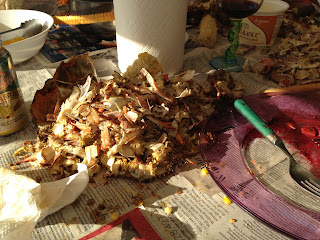Anyhoo, I'm back. In the past month or so, I have been down to Rock Hall, MD twice to visit with the parents. For those of you who don't know, my dad and Linda live right smack on the Chesapeake Bay in a wonderful house called Silly Manor. They have been there for quite a while now. It is paradise on earth. Here's the house:
They work very hard on their gardens, which are as pretty as any English Cottage anywhere. What the hell, here are some more pictures:
Ok, so now you get the idea. Anyway, whenever anyone shows up there, Linda always makes sure there is fantastic food, and plenty of it. She is a really good cook. Her soups, salads, ribs...pretty much everything she makes is great. And dad opens a mean bottle of wine! This is the time of year, however, that one dinner per visit must be hard shelled crabs. And that, my friends, is the subject of tonight's diatribe-er, blog entry.
CALLINECTUS SAPIDUS. The Beautiful Swimmer. The Chesapeake Bay Blue Crab. What a work of nature. And just darn yummy in any form. During the growth cycle, they molt, at which point they are called soft shells. These can be cooked (sautéed, deep fried) and eaten whole, because they have shed their shell and have only a very soft "skin." The meat of the hardshell crab can be used in any number of ways, most popularly in crabcakes. I don't usually eat crabcakes, because most restaurants or recipes add fillers like peppers or onions, which I think completely cover the taste of the crab. I have an amazing recipe for crabcakes, which I will share at a later date. Right now, we're going to discuss the ritual of picking and eating crabs. The proverbial Crabfeast. During summer on the Bay, this includes local sweet corn and tomatoes. Oh, and beer.
Let's talk a bit more about the crabs. Crabbing on the Bay is a time honored tradition. The Chesapeake Waterman is one of the hardest working souls around. Finding the crabs, catching the crabs..it is an art form. Long days, hard work, sometimes very little reward. Crab population fluctuates wildly from year to year, for many reasons. Could be the weather patterns. The pollution in the Bay. Over fishing at the wrong time of year. And then there are the natural predators. The three big seafood populations we most commonly associate with the Chesapeake Bay are crabs, oyster, and striped bass. And..they all eat each other. So, sometimes when the oyster supply is low, it's because the crabs are abundant and eating the spats. And the stripers eat the young crabs, so that has an effect on the crab population. The crabs, well they eat everything, including each other.
The best crabs for eating are the males. The females are usually (hopefully) thrown back to keep the population up. There are different sizes, but the best are the #1 males, or the jumbos. If you have a stove and a pot big enough, you can cook them yourself, steaming them with some crab boil seasoning. We usually get them cooked, to avoid that crazy process of jamming angry live crabs into a pot of steaming water. Dad orders them from Chester River Seafood. River crabs tend to be the bigger crabs, as they have more hiding places in the river shallows to grow bigger and feed undisturbed by the boat traffic in the bay itself. Prices obviously vary from year to year. This seems so far to be a pretty good season.
So let's get into this. First, you need a table, lined with brown paper or newspaper. That way, when the carnage is over, you just fold the whole mess up and throw it away. Each person needs either a nutcracker or a crab mallet, and some people like small knives to get into the shells. A big roll of paper towels should be handy. This is a messy, but worthwhile, undertaking. Don't get dressed up.
Ok, grab a crab. On the belly, you can see what looks like a pull tab. (They really make it easy for you to eat them.) Pull the tab, then pull the top (carapace) off. Clean out the guts (unless you like them) and the gills, and break the body in half, then in half again. Take off the claws and put aside, unless you want to eat them first. Now, you just sort of peel away at some of the inner softer shell and reveal big old chunks of meat. Take the time to pop open all the little swimming legs, there are little bits of meat in there, too. Then use the mallet or the cracker to open the claws and extract the meat. Repeat until you are too full to move, or all the crabs are gone. Stop occasionally for a swig from your beer, to eat a piece of corn or jam a slice of tomato in your face. You may stab yourself once or twice with a piece of shell, just lick the crab spice out and power on. You'll find the cuts again later when you rinse off. Here's some family hard at work:
And then, it's all over. You will be full, happy, a little overloaded on sodium, and smell like Old Bay. Clean up, rinse off, and relax. Start planning the next crabfeast. I know mine will be at the end of the month, when my brother and his clan venture down from Boston to Silly Manor. Until then, I will go on a search for softshells, and cook up some beauties for the next blog. I leave you with a picture of the table after the work is done..
Peace, my friends. See you all soon.










No comments:
Post a Comment